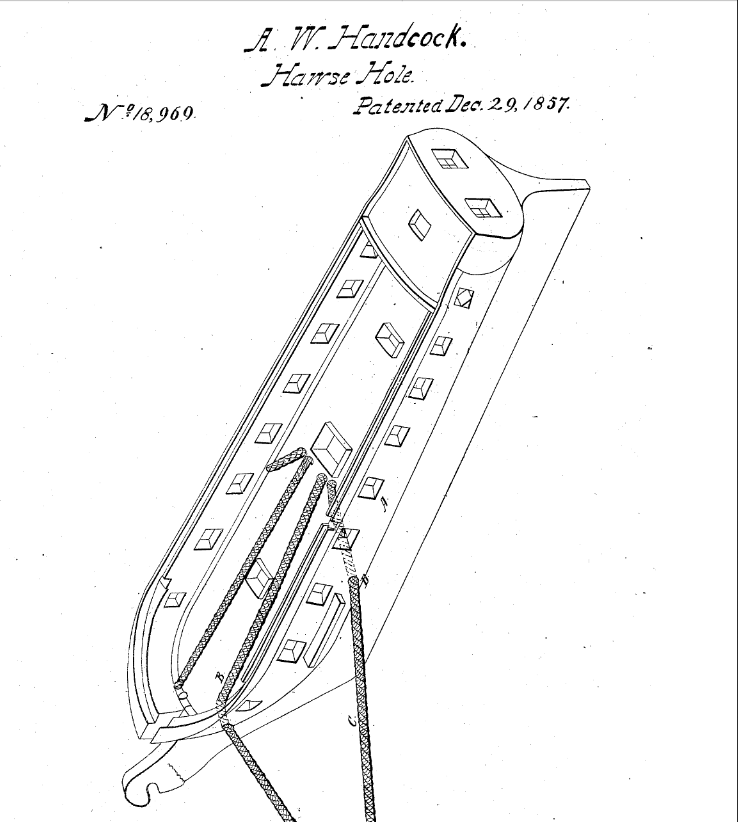ARMIGEL W. HANDCOCK, OF ALLEGAN COUNTY, MICHIGAN
MOORING VESSELS.
Specification of Letters Patent No. 18,969, dated December 29, 1857.
To all whom it may concern:
Be it known that I, ARMIGEL W. HANDCOCK, of Allegan county, Michigan,
have invented a new and useful Improvement in the Method of Mooring Vessels During Foul Weather, whereby the
vessels are prevented from dragging their anchors, the said improvement being effected by the use of two anchors
"let go." one from the hawserhole at the bow and one from the hawserhole which I especially construct therefor in
the waist; and I do hereby declare the following to be a full, clear, and exact description of the same, reference
being had to the annexed drawing, lettered to correspond with the specification and made part of the same.
Having had considerable experience at sea and in the naval service of the United States I have frequently had
to contend with dangers arising from the dragging of the anchors during heavy storms even when the ship was riding
over good anchoring ground. My attention being thus especially directed to counteract or prevent such a condition of
things I have invented a method of anchoring vessels by means presently to be described, whereby a vessel rides more
easily and securely by two anchors on a side, than she would with four anchors "let go" from the usual hawser holes
or out of the "bridal ports" at the bow.
Through the means involved in my invention a vessel receives the
wave at the bow and resists it by the bow anchor until the strain is taken off the bow anchor and transferred to a
"waist anchor" which I "let go" on the same side of the ship with the bow anchor in use, from a hawser hole which
especially construct for this purpose sufficiently far abaft the fore-chains to let the vessel ride as it were on a
center, the resistance to the force of the wave being shifted from the bow anchor to the waist anchor, thus causing
the bow of the ship to be lifted up by the wave as it reaches the axis of motion due to the fixed point given to the
hawser by which the waist anchor holds the ship--the two anchors being also made to operate in conjunction by the
hawsers being paid out til they are on an even strain. The weight of the vessel is thus brought into play in order to
counteract the driving force of the wave, because the vessel becomes a lever the fulcrum of which is the wave itself
as it reaches the perpendicular of the hawser-hole abaft the fore-chains. Hitherto the vessel has either had to be
capable of resisting the driving force of the wave, be driven and drag with themomentum due to her entire weight.
In the drawings (A) is the hull of the vessel riding at anchor by the means by which I effect the
purposes set forth.
(B) is the hawser paid out at the bow.
(C) is the hawser paid out at the
hawser-hole (D) which I purposely and especially fix at a point abaft the fore-chains--the said hawsers being attached
the one to a bow anchor and the other to a waist anchor--two anchors thus arranged and operated being far more
effectually secure than four anchors "let go" as usual at the bow-hawser holes or bridal-ports.
What I
claim therefore and desire to secure by Letters Patent is--
Mooring a vessel during foul weather by means
of two hawsers (B) and (C) paid out at the usual bow hawser hole and at the hawser hole (D) which I especially construct
abaft the fore chains whereby a bow anchor and a waist-anchor are arranged and operated substantially in the manner and
for the purposes set forth.
AMRMIGE W. HANDCOCK
Witnesses:
THOMAS DONN,
THOMAS G. CLINTON.
|
 Click to enlarge
Click to enlarge
image from patent
application |




 Return
To Home Page
Return
To Home Page
